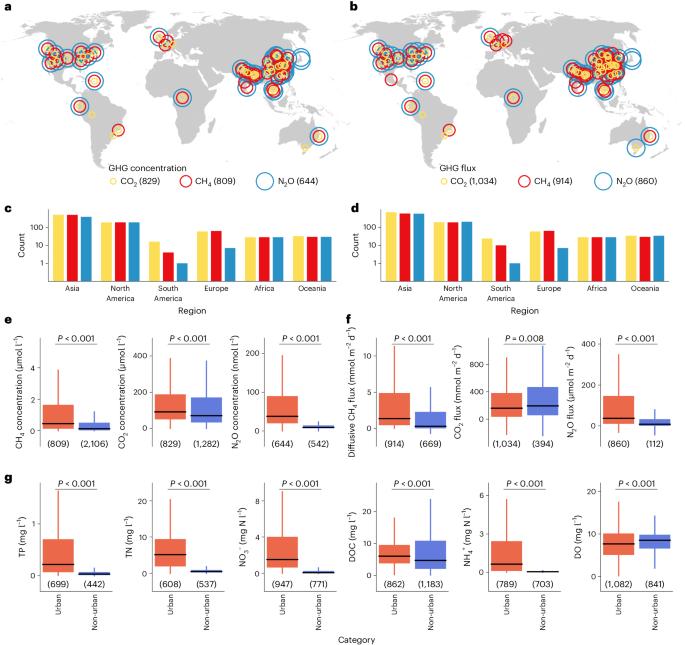受污染的城市河流导致全球温室气体排放增加
IF 25.7
1区 环境科学与生态学
Q1 ENVIRONMENTAL SCIENCES
引用次数: 0
摘要
城市是全球人为温室气体(GHG)排放的核心,而城市景观中的河流则是一个潜在的巨大温室气体源,但尚未得到定性。城市河流排放温室气体的原因是城市环境及其流域过量的碳和氮输入。根据城市河流温室气体数据集和可靠的建模,我们估计全球城市河流每年排放 1.1、42.3 和 0.021 千兆克甲烷(CH4)、二氧化碳(CO2)和氧化亚氮(N2O),总计 78.1 ± 3.5 千兆克二氧化碳当量(CO2-eq)。预测的温室气体排放量几乎是非城市河流排放量的两倍(~815 对 414 mmol CO2-eq m-2 d-1),在强度上与范围-1 城市排放量相似(1,058 mmol CO2-eq m-2 d-1),特别是较高的 CH4 和 N2O 排放量与城市河流广泛的富营养化以及碳和养分循环的改变有关。从全球来看,排放量随国民收入水平而变化,排放量最高的国家是河流污染控制不足的中低收入国家。这些发现强调了污染控制在减少城市河流温室气体排放和确保城市可持续发展方面的重要性。城市是全球温室气体排放的主要来源,但人们对城市河流排放温室气体的潜力并不十分了解。现在,一项研究对全球城市河流的温室气体浓度、通量和排放量进行了量化。本文章由计算机程序翻译,如有差异,请以英文原文为准。

Globally elevated greenhouse gas emissions from polluted urban rivers
Cities are at the heart of global anthropogenic greenhouse gas (GHG) emissions, with rivers embedded in urban landscapes as a potentially large yet uncharacterized GHG source. Urban rivers emit GHGs due to excess carbon and nitrogen inputs from urban environments and their watersheds. Here relying on a compiled urban river GHG dataset and robust modelling, we estimated that globally urban rivers emitted annually 1.1, 42.3 and 0.021 Tg CH4, CO2 and N2O, totalling 78.1 ± 3.5 Tg CO2-equivalent (CO2-eq) emissions. Predicted GHG emissions were nearly twofold those from non-urban rivers (~815 versus 414 mmol CO2-eq m−2 d−1) and similar to scope-1 urban emissions in intensity (1,058 mmol CO2-eq m−2 d−1), with particularly higher CH4 and N2O emissions linked to widespread eutrophication and altered carbon and nutrient cycling in urban rivers. Globally, the emissions varied with national income levels with the highest emissions happening in lower–middle-income countries where river pollution control is deficient. These findings highlight the importance of pollution controls in mitigating urban river GHG emissions and ensuring urban sustainability. Cities are a major source of greenhouse gas emissions worldwide, but the potential of urban rivers to such emissions is not well understood. A study now quantifies the greenhouse gas concentrations, fluxes and emissions from urban rivers globally.
求助全文
通过发布文献求助,成功后即可免费获取论文全文。
去求助
来源期刊

Nature Sustainability
Energy-Renewable Energy, Sustainability and the Environment
CiteScore
41.90
自引率
1.10%
发文量
159
期刊介绍:
Nature Sustainability aims to facilitate cross-disciplinary dialogues and bring together research fields that contribute to understanding how we organize our lives in a finite world and the impacts of our actions.
Nature Sustainability will not only publish fundamental research but also significant investigations into policies and solutions for ensuring human well-being now and in the future.Its ultimate goal is to address the greatest challenges of our time.
 求助内容:
求助内容: 应助结果提醒方式:
应助结果提醒方式:


